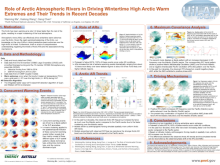Role of Arctic atmospheric rivers in driving wintertime high Arctic warm extremes and their trends in recent decades
Weiming
Ma
Pacific Northwest National Laboratory
Poster
Atmospheric rivers (ARs), filaments of intense moisture transport in the atmosphere, are responsible for most of the atmospheric moisture transported into the Arctic. Their presence over the Arctic can trigger a wide range of weather extremes. Based on hourly reanalysis dataset, we first characterize wintertime high Arctic warm extremes during 1980-2021. Atmospheric blocking patterns over the northern Eurasia are identified as a key ingredient in driving these events, as they can effectively deflect the eastward propagating cyclones poleward, facilitating intense moisture and heat intrusions into the high Arctic. Using an AR detection algorithm modified for high latitude, the characteristics of Arctic ARs and their role in driving these warm events are explicitly quantified. ARs are identified as the direct driver for most of these historical Arctic warm extreme events. Given the importance of ARs in driving the Arctic extreme weather, we also investigate the Arctic AR trends in recent decades. Using reanalysis data and CMIP6 large ensemble simulations, we show that the observed Arctic AR frequency increased by twice as much over the Atlantic sector than the Pacific sector. In contrast, the externally forced Arctic AR trends based on CMIP6 models are spatially more uniform. This discrepancy between the observed trend and the simulated trend can be reconciled by the phase shift of the Interdecadal Pacific Oscillation (IPO) and Atlantic Multidecadal Oscillation (AMO) in recent decades. More specifically, the observed negative phase shift of IPO and positive phase shift of AMO both favor AR increases over the Atlantic sector and AR reductions over the Pacific sector. Given the dominant role of IPO and AMO in the Arctic AR decadal variability, we further demonstrate how their historical statistics can be used to constrain future Arctic AR changes.

ma-weiming-polar-poster.pdf
(1.85 MB)
